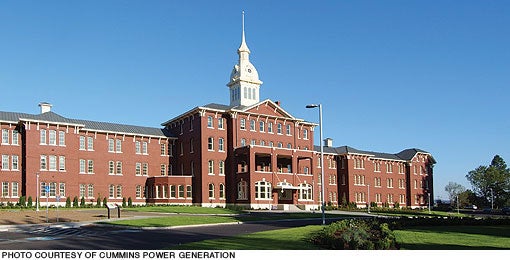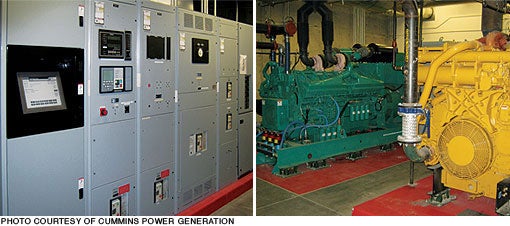In sync
 Health care facilities like hospitals, clinics and nursing facilities not only need a dependable power source to ensure continuous patient care, but in North America, are required to meet standards as established by National Electrical Code (NEC), National Fire Protection Association, International Electrotechnical Commission, as well as licensing from both national and local administrative bodies.
Health care facilities like hospitals, clinics and nursing facilities not only need a dependable power source to ensure continuous patient care, but in North America, are required to meet standards as established by National Electrical Code (NEC), National Fire Protection Association, International Electrotechnical Commission, as well as licensing from both national and local administrative bodies.
Every health care facility has its own unique set of issues to consider when designing, installing and commissioning an emergency power system. Emergency power systems must be a dependable, efficient and energy saving power source. These systems represent sizable investment to operate and maintain. Efficient tailoring of designs and equipment is critical. Facility managers have to ensure they select the best system to meet their individual facility needs.
The following case studies show how several hospitals designed and installed power system to overcome challenges and fulfill their facilities power needs.
Case 1: Consider all resources
Oregon State Hospital in Salem, N.C., was built in 1883 and over the years had seen several renovations. The updates created a better facility, but a less than ideal power configuration. Multiple utilities provided electricity to different parts of the campus. Eight separate generator sets provided standby power for individual buildings.
To rectify the situation and complete other facility improvements, the hospital initiated a Hospital Replacement Project, a $458.1 million expansion of two hospitals. For the Salem facility director, the migration to a single power station was a big challenge, especially with limited capital. The resolution came from leveraged expertise, money and resources through partnerships with the local utility, an engineering firm, power generation manufacturer and distributor.
 |
| Oregon State Hospital created partnerships to secure capital. |
Oregon State Hospital gained upfront capital for an improved power system through the utilization of local utility's dispatchable standby generation program (DSGP). The program provided utility with a supplemental power source, while they also assumed responsibility of operation and related costs for maintenance for generator sets, fuel systems and some controls. In return, the utility could use the backup power for up to 400 hours a year, if needed.
The partnership also increased the level of system design complexity. Therefore Oregon State Hospital knew it was important to purchase all power system components — controls, generator and switchgear — from one manufacturer. Taking the approach ensured better dependability and efficiency with all the components designed to work together. A complete 2-megawatt (MW) system was purchased with a paralleling system, 800- and 400-amp bypass switches, and two 2-MW generator sets in sound-attenuated housing.
To ensure the system would run successfully from day one, Oregon State Hospital visited the manufacturer and observed the system being put through an extensive series of tests to identify any potential causes for concern. Also to reduce the number of modifications needed at time of installation and commissioning. The end result has been a system that has operated successfully from the day it was installed.
Case 2: Pre-planning is the key
The AnMed Health Medical Center in Anderson, S.C., had been serving its community for over 100 years. In recent years, the hospital had experienced increased energy demands and wanted to expand their central utility plant. They also needed to upgrade their power system to the latest NEC code requirements. Furthermore, they wanted a customized power monitoring and control system as well as improved overall power reliability.
To ensure the system met all of their needs, pre-planning was very important. Successfully executing a major upgrade to a century-old facility under tight deadlines while the hospital continued to function was a complex planning and logistical challenge. Detailed discussions were held about preliminary system design and the sequence of operations that involved the local utility. The hospital developed detailed specifications and sought bids for a comprehensive upgrade to its electrical plant, including a new emergency power system.
The chosen supplier brought in technicians and engineers from the manufacturing plant to design generator sets, transfer switches and paralleling switchgear that would interact successfully with the local utility. The end result was a new system of three, 2000-kilowatt (kW) generator sets, paralleling switchgear and automatic transfer switches that would meet all of the centers current and future power needs. The design allowed for a fourth generator set to be easily installed — without interrupting service or adding to the wiring or switchgear — to maintain N+1 redundancy.
System installation and transfer planning was also important. Despite what stage the project was at, standby power had to be available for patient care 24/7. The power generation distributor took the lead, managing a complex series of interactions with multiple vendors. The new system was built alongside the one being replaced. Loads were gradually transferred from the old to the new system, and the old system was subsequently dismantled.
While replacing the entire electrical system, all the normal, non-emergency circuits were moved over to the new system one at a time. One big transfer of the emergency circuits was made for the new construction part of the project, and then a second big switch for the older part of the hospital.
Despite all of the planning, unexpected things happened. Shortly after the system was installed, a black snake found its way into the hospital's dedicated electrical substation, short-circuiting the supply of utility power. The standby system kicked in automatically and performed exactly as planned, picking up emergency loads within the required 10 seconds.
Success of the project was due to the excellent complex planning and logistical coordination of team members. This teamwork included the hospital's management and engineering staff as well as several external firms. These first-class results have won national recognition with an American Society for Healthcare Engineering VISTA Award for Infrastructure.
Case 3: Linking competitors
Providing children's health care in an atmosphere of love and concern is the guiding mission of Primary Children's Medical Center, Salt Lake City, Utah, named among the Best Children's Hospital for 2011-2012 by US News and World Report in several specialties. Children come from not just Utah, but a five-state region including Idaho, Montana, Wyoming and Nevada.
It was an award-winning facility with a less that adequate standby power system. The facility had been built with cogeneration engines that were fueled with natural gas. The engines were old, were costly to run and maintain, and end-of-life support was a problem. A 1500 kW diesel generator had been added, but the system was still unable to meet their power needs. The diesel generator also created a system, which required manual operation, not the hands-free system Primary Children's Medical Center once had and wanted to have again.
The hospital needed a 4-MW system that provided standby power not only for critical systems, but for over 90 percent of the entire facility during a power outage. They also wanted a system that utilized the existing 1500-kW diesel generator. Furthermore, the entire system had to be delivered through a small opening into the basement.
The hospital selected a generator manufacturer to supply one 1500-kW and two 1250-kW generator sets and a paralleling system, despite their concerns about compatibility with the old generator from another manufacturer.
 |
| One challenge was controlling and paralleling generator sets from different manufacturers. |
Incompatibility was related to winding pitches, which were different on the old generator set and the new generator set. The wrong circulating current can damage the alternator. A solution was developed for adding an automatic disconnect switch that would take the neutral of the new generator set offline when both were paralleling, to prevent circulating currents. All units were then controlled and monitored by a digital master control, which also monitored and controlled all of the existing transfer switches.
With the compatibility issues solved, it was time to overcome delivery and installation. The two, 1250-kW units had to be passed through a small opening in the parking structure and lowered into the generator room 20 feet below. The generator sets were taken apart, turned on their sides and lowered by crane into the basement.
After the system was in place it had to be tested without affecting the hospital. A 2-MW rental power unit was brought in by the distributor. All of the demolition, installation and testing was done middle of the night with the hospital still in operation, providing services and care.
The hospital now has a system configuration that enables paralleling with the local utility. They also have technical and maintenance support for the local distributor.
Critical infrastructure
Securing a reliable power source is critical for all health care facilities to ensure patient care will be uninterrupted regardless of threats like utility overload or natural disaster power outages. Creating a dependable system is reliant upon all components — controls, switchgear, transfer switch and the generator — working together in unison as one system.
George Williams is a regional general manager with Cummins Power Systems division of Cummins Power Generation. He can be reached at george.l.williams@cummins.com




